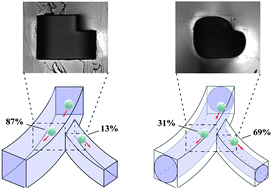Traffic of leukocytes in microvascular networks (particularly through arteriolar bifurcations and venular convergences) affects the dynamics of capillary blood flow, initiation of leukocyte adhesion during inflammation, and localization and development of atherosclerotic plaques in vivo. Recently, a growing research effort has been focused on fabricating microvascular networks comprising artificial vessels with more realistic, rounded cross-sections. This paper investigated the impact of the cross-sectional geometry of microchannels on the traffic of leukocytes flowing with human whole blood through a non-symmetrical bifurcation that consisted of a 50 μm mother channel bifurcating into 30 μm and 50 μm daughter branches. Two versions of the same bifurcation comprising microchannels with rectangular and rounded cross-sections were fabricated using conventional multi-layer photolithography to produce rectangular microchannles that were then rounded in situ using a recently developed method of liquid PDMS/air bubble injection. For microchannels with rounded cross-sections, about two-thirds of marginated leukocytes traveling along a path in the top plane of the bifurcation entered the smallest 30 μm daughter branch. This distribution was reversed in microchannels with rectangular cross-sections – the majority of leukocytes traveling along a similar path continued to follow the 50 μm microchannels after the bifurcation. This dramatic difference in the distribution of leukocyte traffic among the branches of the bifurcation can be explained by preferential margination of leukocytes towards the corners of the 50 μm mother microchannels with rectangular cross-sections, and by the additional hindrance to leukocyte entry created by the sharp transition from the 50 μm mother microchannel to the 30 μm daughter branch at the intersection. The results of this study suggest that the trajectories of marginated leukocytes passing through non-symmetrical bifurcations are significantly affected by the cross-sectional geometry of microchannels and emphasize the importance of using microfludic systems with geometrical configurations closely matching physiological configurations when modeling the dynamics of whole blood flow in the microcirculation.

You have access to this article
 Please wait while we load your content...
Something went wrong. Try again?
Please wait while we load your content...
Something went wrong. Try again?


 Please wait while we load your content...
Please wait while we load your content...